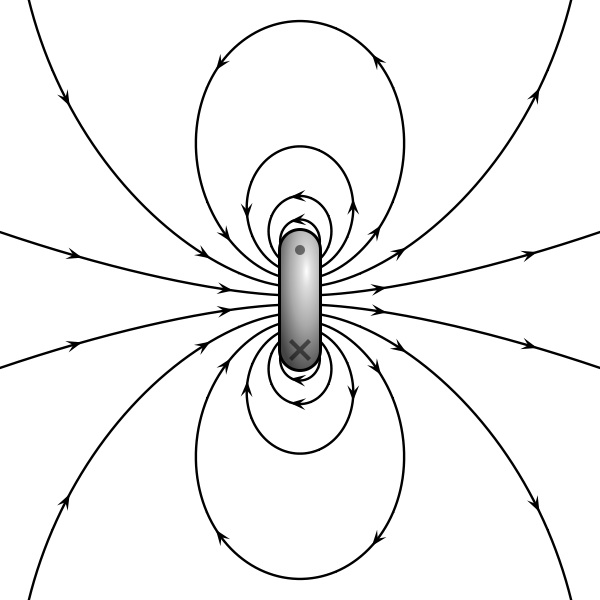Magnetic Dipole Moment
CLAIMED BY SHI YU LIU (FALL 2016)
by Guillermo Bacardi
The magnetic dipole moment of a loop of current may be considered to be a measure of the strength of the magnetic field. The magnetic field generated by a magnet points from south to north and is proportional to its magnetic dipole moment. In a loop of current the magnetic dipole moment is a vector that is perpendicular to the loop and can be found using the right-hand-rule. The magnetic dipole moment is a measure of the strength of the magnetic dipole.
The Main Idea
The main idea for this topic is to define the magnetic dipole moment and distinguish from the magnetic moment. The magnetic moment is a vector quantity that is used to calculate the torque generated by a magnetic field while the magnetic dipole moment is a value used to define the current of a loop to find the magnetic field on axis.
A Mathematical Model
The magnetic dipole moment is represented by µ. This is set equal to the current running through the wire multiplied by the area of the circular loop. Here the area of the circular loop is defined as πR^2. The units for the magnetic dipole moment are amperes times meters squared.
[math]\displaystyle{ \boldsymbol{\mu} = \boldsymbol{I} \times\mathbf{A} }[/math]
If there is more than one coil in the loop then all of the coils must be accounted for by a value N that represents all of the coils.
[math]\displaystyle{ \boldsymbol{\mu} = \boldsymbol{NI} \times\mathbf{A} }[/math]
The overall equation for a magnetic field turns into
[math]\displaystyle{ \mathbf{B} = \frac{\mu_0}{4\pi}\frac{2\mu}{R^3} }[/math]
The magnetic moment µ of an electron is given by
[math]\displaystyle{ \boldsymbol{\mu} = \boldsymbol{I} \times\mathbf{A} }[/math] = [math]\displaystyle{ \frac{-e}{2m_{e}} \times\mathbf{L} }[/math]
Calculation of Quantities Involving Magnetic Dipole Moment
Torque on a current loop
[math]\displaystyle{ \mathbf{τ} = \boldsymbol{\mu} \times\mathbf{B} }[/math]
The potential energy associated with the magnetic moment
[math]\displaystyle{ \mathbf{U(\theta)} = \boldsymbol{-\mu}•\mathbf{B} }[/math]
A Computational Model
This image shows how the magnetic field around a loop changes at each location but on axis with the center of the loop it points in one direction.
Examples
Simple
What is the magnetic dipole moment of a 1200 turn circular coil that has a radius of 10 cm and carries a current of 2 amperes?
Solution: µ=NIA N=1200 I = 2 A = π0.1^2
µ = (1200)(2)(0.0314) = 75.4 Am^2
Middling
What is the magnetic field at a point 3m away from a coil that has 250 turns, a radius of 2m and a current of 4 amperes running through it?
First step is to calculate the dipole moment using µ=NIA. In this situation N=250, A = 4^2π, and
Then plug this into our magnetic field equation [math]\displaystyle{ \mathbf{B} = \frac{\mu_0}{4\pi}\frac{2\mu}{R^3} }[/math] and we get
A = π4^2
I = 4. (250)(4π)(4)= 12566.4Am^2
B = 1e-7((2*12566.4)/9) and B=1.4e-4
Difficult
A thin uniform ring of radius R and mass M carrying a charge +Q rotates about its axis with constant angular speed ω. Find the ratio of the magnitudes of its magnetic dipole moment to its angular momentum.
I = Q/T = Qω/(2π)
µ = AI = πR^2 (Qω)/(2π) = Q(ωR^2)/2
History
The study of magnetism dates far back in time but it was not until 1825 that Andre Ampere showed that magnetism is due to perpetually flowing current through loops of wire. He then went on to derive Amperes force law which connected the magnetic fields to electric currents. This equation was then further adapted to simplify the on axis magnetic field generated by a loop of current to use the magnetic dipole moment.
At first, people thought magnets, both natural and man-made, are made up of countless magnetic dipoles, each consists of a positive and a negative magnetic charges separate by a small distance s. This consequently defined the concept of magnetic dipole moment, a vector, pointing from the negative magnetic charge to positive charge. When scientists discovered that magnetic charges, or "magnetic monopoles" do not exist, instead the magnetic properties of matters are generated by the alignment of molecular currents. Since then, magnetic dipole moment is redefined using current I, allowing the idea of magnetic dipole to remain.
See also
Here are some more resources with extra information on magnetic dipole moments.
Further reading
Lecture on magnetic dipole moment [1]
External links
Internet resources on magnetic dipole moment [2]
TutorVista Magnetic Moment [3]
References
This section contains the the references you used while writing this page
